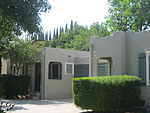Tianqiao and Chrissy Chen Institute
California Institute of Technology buildings and structuresNeuroscience research centers in CaliforniaNon-profit organizations based in CaliforniaUse mdy dates from June 2022
The Tianqiao and Chrissy Chen Institute (also referred to as the Chen Institute or TCCI) is a non-profit institute founded by husband and wife Tianqiao Chen and Chrissy Luo with the aim of supporting study into the human brain. In 2016 the couple committed US$1 billion to support the institute's work, which focuses on research in three core areas – brain discovery, brain treatment and brain development. Towards that end, the institute supports interdisciplinary research concerning neuroscience, particularly research on brain mechanics, perception, and the impact of perception on behavior and well-being.
Excerpt from the Wikipedia article Tianqiao and Chrissy Chen Institute (License: CC BY-SA 3.0, Authors).Tianqiao and Chrissy Chen Institute
South Catalina Avenue, Pasadena
Geographical coordinates (GPS) Address Nearby Places Show on map
Geographical coordinates (GPS)
| Latitude | Longitude |
|---|---|
| N 34.1409 ° | E -118.1294 ° |
Address
South Catalina Avenue 261
91106 Pasadena
California, United States
Open on Google Maps








